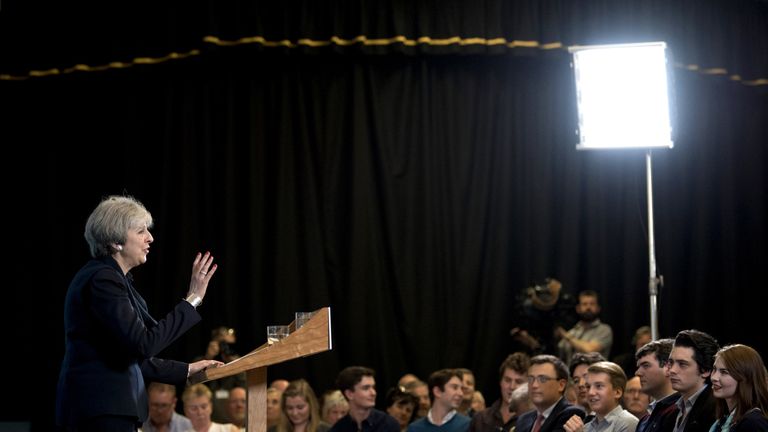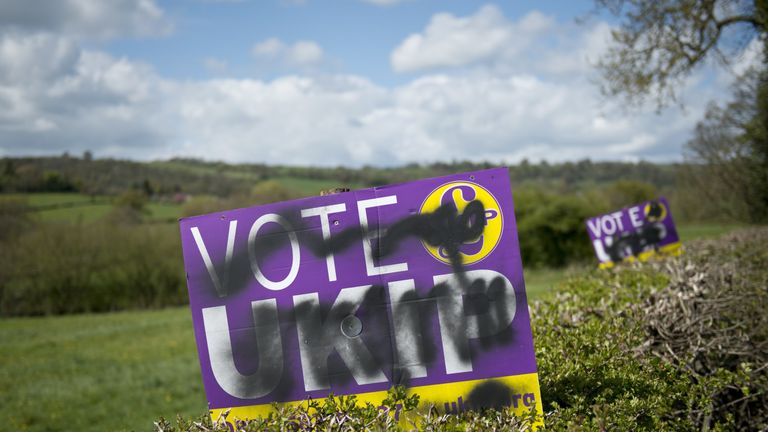Vote 2017: How Theresa May could land a 212 majority win
How could Theresa May deliver a landslide win and score a majority of more than 200? Sky's Election Analyst does the maths.
Saturday 13 May 2017 11:40, UK
Most of the money being wagered at this election centres on the likely number of seats won by each party or on the scale of the Conservative victory.
Previously, I speculated that should the investigation into Conservative spending in marginal constituencies in 2015 lead to prosecutions then the scandal might, just might, give Labour an outside chance of springing an election surprise.
No prosecutions, no surprise, therefore.
they also show that voters perceive Jeremy Corbyn as too left-wing, the party divided and, where 'leadership' is concerned, the referee should have stopped the fight long ago and declared the blue corner as winner.
The recent council elections, however, whilst good for the Conservatives, saw the party's national equivalent vote, an estimate of how the country as a whole might have voted, fall short of the figure suggested by the polls.
In 1997 a majority of the final opinion polls were suggesting Labour would almost win half the votes. It won 44%.
Similarly, in 1983, Margaret Thatcher's Conservatives were deemed more popular by the polls than by the voters.
Each of those elections produced landslides - 144 seats for Mrs Thatcher and the post-war record 178-seat majority for Tony Blair.
But even these events are eclipsed by the SNP's performance in 2015. Fighting just 59 constituencies the party won all but three of them. Winning half the votes cast across Scotland led to the SNP winning 95% of the seats.
Under our 'first past the post' voting system when a party dominates the votes to this extent we pass a 'tipping point', whereby a marginal increase in vote share leads to a much larger accumulation of seats.
Should half the nation's voters on 8 June support the Conservatives, and that support was more or less the same across all constituencies, then Mrs May too would capture the vast bulk of the available 650 seats.
Popular though she undoubtedly is there are still parts of the country where Conservative candidates will not receive such support.
So, how might the Conservative landslide occur?
In 2015, UKIP established an unenviable record - the most votes received for the reward of a single seat. More than one in eight voters backed UKIP. Significantly, in the recent county council elections much of UKIP's vote went directly to the Conservatives.
What would happen if say, eight in 10 voters that supported UKIP in 2015 switched to the Conservatives this time?.
Such a movement of voters would see the Conservatives grow from 331 to 394 seats, largely at Labour's expense. This is a Commons' majority of 138 seats.
To take it to the next level beyond this UKIP bounty Mrs May needs to attract former Labour voters.
Current polling suggest the Conservatives have support from about 46% of voters, an eight-percentage point rise. Labour is marooned below 30%, about a two- or three-point drop.
Assuming a rather modest 2% swing directly from Labour to the Conservatives, therefore, gives Mrs May an extra lift, resulting in 420 seats and now a 190 majority.
Interestingly, the numbers still show SNP seats virtually untouched. This is simply because its existing majorities over the Conservatives are large. The 2015 election in Scotland was highly unusual for the remarkable rise in SNP's vote, an unprecedented 30 percentage point increase.
What goes up may come down and if the Conservatives can harness those voters who rejected independence in the 2014 referendum in the same way the SNP did for 'Yes' voters then a large swing is possible.
Factoring in a 10% movement away from the SNP and some strategic voting towards the strongest party campaigning for the union might present the Conservatives with an additional eleven gains.
This now takes the Conservative total to 431 seats and a majority of 212, the largest since the 1930s.





